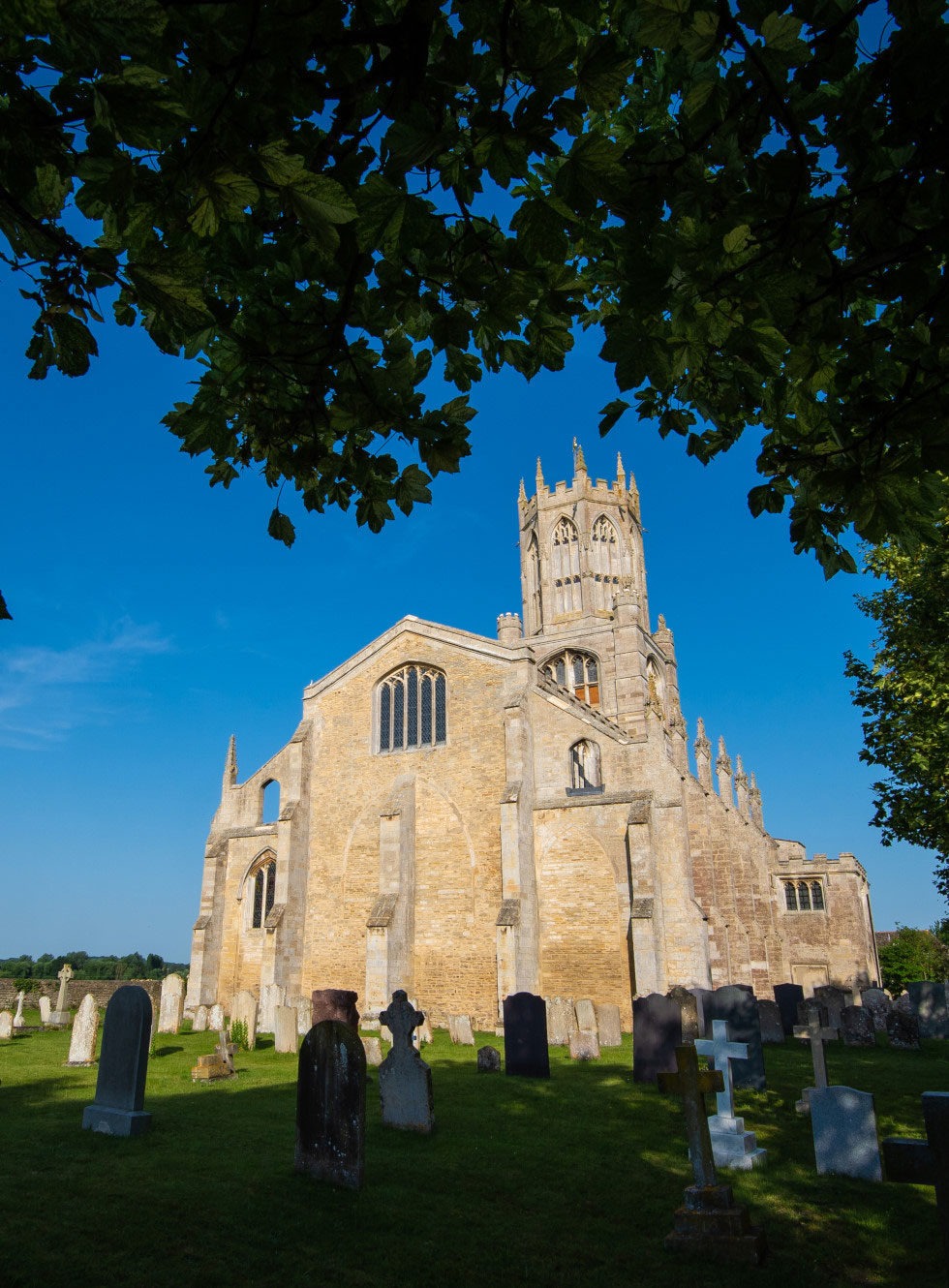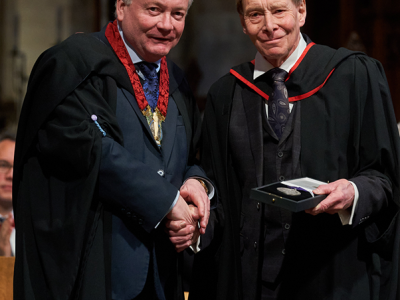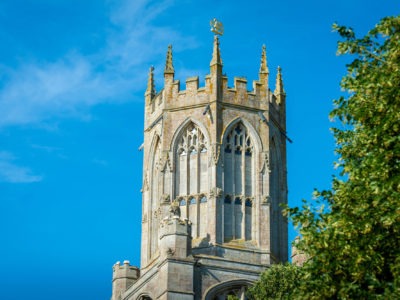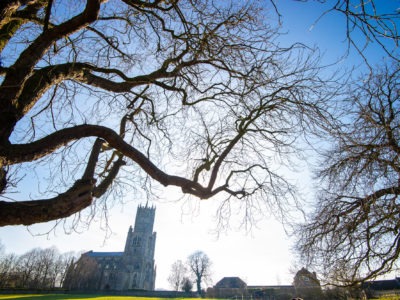History

Death in Fotheringhay
Strolling through the delightful village of Fotheringhay at the eastern end of Northamptonshire, on the borders of the English fenlands, one quickly appreciates that this is no ordinary one street village. Approaching the village from the west, passing ranges of beautiful fifteenth century cottages, and the very welcoming and alluring Falcon Inn, one soon realises that Fotheringhay is more than a chocolate box English village. On the right looms the strangely truncated form of Fotheringhay Church with its superb octagonal lantern tower. The rules of proportion for English ecclesiastical architecture immediately suggest that once upon a time this fine perpendicular gothic building with its stylish flying buttresses was once twice its present size. Round the corner, past the cottages which once made up the old inn and the large building created by King Edward IV for visitors, you reach the old stone bridge across the river Nene, which was the reason for Fotheringhay’s existence. Turning to your left as you cross the bridge, you see the motte and bailey of the ancient castle. Though only one small piece of masonry remains, it is clear that the small village of Fotheringhay must once have been an important place.
And an important place it certainly was. Fotheringhay was important not just locally but nationally. From the time of the Normans to the advent of the Stuarts, it was directly linked to the royal families of both Scotland and England. Here a future king of England, Richard III, who would die on Bosworth Field was born; here a queen of Scotland, Mary, Queen of Scots, accused of murdering her husband and plotting the destruction of Queen Elizabeth, was publicly executed. Here a royal duke, killed fighting the French in battle at Agincourt in 1415, was buried; here too a royal duke and his son killed in battle nearer home, at Wakefield in Yorkshire, were re-buried. Here an English King, Edward IV, plotted and failed to replace the king of Scotland with his brother, just as his own brother, The Duke of Clarence, had plotted against him. Meanwhile the Church in Fotheringhay deformed but defiant stands testament to the destruction wrought by Henry VIII’s Reformation. Between 1100 and 1612 Fotheringhay was a place to be reckoned with, a place which reflected and took part in many of the bloody events which shaped the history of two nations. Many of the good and the great associated with Fotheringhay, many of the movers and shakers of their day would meet violent deaths. Death and Fotheringhay were always closely entwine!
The Castle
A violent death by beheading befell the last Anglo-Saxon owner of the manor of Fotheringhay. Waltheof, Earl of Northampton who had survived the Norman Conquest of 1066 and been rewarded with marriage to the Conqueror’s niece, Judith, was beheaded in 1076 after his second rebellion against England’s new masters. His daughter Maud, married Simon de St Liz, who built the castle at Fotheringhay around the year 1100, just one generation after the Conquest. St Liz was a keen castle builder and the strategic significance of Fotheringhay in the years after the Norman Conquest was clear to all. On the edges of the great forest of Rockingham, but also bordering on the dangerous fenlands, which had seen the last great English rebellion against the Normans by Hereward the Wake, Fotheringhay was an important river crossing of the River Nene, just downstream from the market town of Oundle and upstream from the great Abbey Church in Peterborough, which had often been the target of marauding Danes. The Danes were still a threat into the twelfth century and a strong point at Fotheringhay was clearly thought desirable by Earl Waltheof’s son-in-law. The great motte was raised by hand by slave labour and the original buildings would have been made of wood. Since the village was owned by Maud St Liz, it passed to her second husband who was David I, King of Scotland. So began a lengthy period when the castle was owned by kings of Scotland. When David I died in 1153, he was succeeded by Malcolm IV (the Maiden) and then by his brother William I (the Lion) who was king from 1165 to 1214. From there, Fotheringhay and the earldom of Huntingdon passed to William I’s nephew, the aptly named John le Scot. From him it went to John de Balliol, father of John Balliol who was briefly king of Scotland until unseated by Edward I of England. The Fotheringhay Balliol founded Balliol College in Oxford and the College’s first master was Walter of Fotheringhay. The village’s associations with English education didn’t end there. Edward III at one time granted the manor to Mary of Valence, Countess of Pembroke who went on to found Pembroke College in Cambridge.
The castle was captured just once. In 1221, William, Earl of Albermarle captured it briefly and plundered the countryside round about in a rebellion against his uncle, Henry III. He had earlier captured Rockingham castle but in the end was reconciled to the king.
Fotheringhay’s importance in English history was further enhanced when Edward III granted the castle and manor to his fourth surviving son Edmund of Langley, who would become Duke of York and be the founder of Fotheringhay College and of the great Yorkist dynasty which would rule England from 1461-85. He seems to have spent money on improving the fortifications of the castle. His son Edward, second Duke of York made Fotheringhay his principle residence and spent more money improving the castle. He was one of the few English casualties at the Battle of Agincourt and was buried in the collegiate church in the village. His nephew, Richard, became the third Duke of York in 1415.
With the earldom of Cambridge from his father, the dukedom of York from his uncle Edward and with a Mortimer heiress for a mother, Richard of York became the greatest magnate in the land in the troubled reign of Henry VI. Fotheringhay was favoured by him and his eldest daughter, Margaret, and youngest son, Richard (who would become King Richard III) were born in the castle. Young Richard, born in 1452, spent the first 6 years of his life based in the castle until the advent of the Wars of the Roses in 1459. His father was killed alongside Richard’s older brother Edmund, Earl of Rutland at the Battle of Wakefield in 1460. However, just weeks later, their deaths were avenged by the late Duke of York’s eldest son, Edward of March. He defeated his Lancastrian foes at Towton, early in 1461 and became King (as Edward IV) in place of the enfeebled Henry VI.
Although overthrown briefly in 1470-1, Edward’s reign was more peaceful than it seemed and in his second reign he was able to restore peace and stability to the realm. Fotheringhay was always important to him and he lavished money on the castle and in
extending accommodation in the village for guests, by building the so-called New Inn just outside the castle walls. He negotiated a treaty in Fotheringhay with Alexander, Duke of Albany, the King of Scotland’s brother and this led to a successful invasion of Scotland by Albany and Richard of Gloucester (the Fotheringhay boy!) in 1482. In a huge setback for James III of Scotland, Edinburgh was occupied and plundered, Berwick was captured permanently for the English and Albany briefly took charge of the country. In the short-term, the Treaty of Fotheringhay had worked out well!
Later the castle was owned by Catherine of Aragon, first wife of Henry VIII and she spent money in repairing the castle buildings. Perhaps because of its Scottish connections, Fotheringhay Castle’s most infamous hour came in 1586-7, when it was the scene of the trial and subsequent execution of Mary, Queen of Scots on the 8th February 1587. It is often claimed that the accession of her son James I to the English throne in 1603, helped to seal the castle’s demise. However, by the end of his reign in 1625, the castle was still described as “meetly strong”. A decade later, however, it was deserted and falling into ruin, so that today just one piece of masonry remains of this once impressive fortress.
Colin Pendrill, Local Historian
Latest news
Find the latest news and updates from The Friends of Fotheringhay Church, including updates on the Church of Saint Mary the Virgin and All Saints, as well as the village and surrounding area.
Plan a Visit
Experience Part of History
If you are looking to visit Fotheringhay, we can help provide you with all the information you need to plan out your visit and have the most enjoyable experience of the village, Church and surrounding areas. Learn more about the delightful landscape, sights and sounds of the local area, and the deep history of Fotheringhay village and the Church, so that when you arrive, you can truly get the most out of your visit.
Testimonials
“Whilst on a countryside walk, we stepped into this lovely church and were so glad that we did. Although a working church, there is also space for a small museum and the story of the church.”
“Glancing at the details of the church building and monuments, you know you are in King Richard III country and a place with royal historic connections.”
“A fascinating, and very old, church with useful information on the history of Fotheringhay and Mary Queen of Scots.”
“An unusual church, having lost over half its length when it's collegiate function was taken away during the reformation. The remaining building is high and wide with the seating in box pews.”
Plan a Visit
Experience Part of History
If you are looking to visit Fotheringhay, we can help provide you with all the information you need to plan out your visit and have the most enjoyable experience of the village, Church and surrounding areas. Learn more about the delightful landscape, sights and sounds of the local area, and the deep history of Fotheringhay village and the Church, so that when you arrive, you can truly get the most out of your visit.



